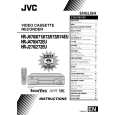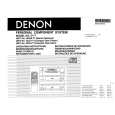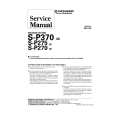|
|
|
Productos
|
|
Información
|
|
Destacado
|
|
|
 |
|
|
No hay comentarios de productos.
TK-480/481
CIRCUIT DESCRIPTION
5. Frequency Synthesizer Unit
5-1. Frequency synthesizer
The frequency synthesizer consists of the VCXO (X2), VCO (IC14), PLL IC (IC11) and buffer amplifiers. The VCXO generates 16.8MHz. The frequency stability is 1.5ppm within the temperature range of �30 to +60°C. The frequency tuning and modulation of the VCXO are done to apply a voltage to pin 1 of the VCXO. The output of the VCXO is applied to pin 8 of the PLL IC. The TK-480�s VCO covers a dual range of the 806~ 825MHz, and the 851~870MHz. The VCO generates 806.15~825.15MHz for providing to the first local signal in receive. In TA mode, the pin 1 of the VCO goes low and the VCO generates 851~870MHz. The TK-481�s VCO covers a dual range of the 896~ 902MHz, and the 935~941MHz. The VCO generates 890.15~896.15MHz for providing to the first local signal in receive. In TA mode, the pin 1 of the VCO goes low and the VCO generates 935~941MHz. The output of the VCO is amplified by the buffer amplifier (Q8) and routed to the pin 5 of the PLL IC. Also the output of the VCO is amplified by the two-buffer amplifier (Q10, Q17) and routed to the next stage according to T/R switch (D4, D5). The PLL IC consists of a prescaler, fractional divider, reference divider, phase comparator, charge pump. This PLL IC is fractional-N type synthesizer and performs in the 100kHz reference signal which is eighth of the channel step (12.5kHz). The input signal from the pins 1 and 5 of the PLL IC is divided down to the 100kHz and compared at phase comparator. The pulsed output signal of the phase comparator is applied to the charge pump and transformed into DC signal in the loop filter (LPF). The DC signal is applied to the pin 3 of the VCO and locked to keep the VCO frequency constant. PLL data is output from DT (pin 52), CP (pin 64) and EP (pin 69) of the microprocessor (IC15). The data are input to the PLL IC when the channel is changed or when transmission is changed to reception and vice versa. A PLL lock condition is always monitored by the pin 21 (UL) of the microprocessor. When the PLL is unlocked, the UL goes low.
6. Control Circuit
The control circuit consists of microprocessor (IC15) and its peripheral circuits. It controls the TX-RX unit and transfers data to and from the display unit. IC15 mainly performs the following; 1) Switching between transmission and reception by PTT signal input. 2) Reading system, group, frequency, and program data from the memory circuit. 3) Sending frequency program data to the PLL. 4) Controlling squelch on/off by the DC voltage from the squelch circuit. 5) Controlling the audio mute circuit by decode data input. 6) Transmitting tone and encode data.
6-1. Memory circuit
Memory circuit consists of the CPU (IC15) and a flash memory (IC17), a flash memory has a capacity of 2M bits that contains the transceiver control program for the CPU and data such as transceiver channels and operating features. This program can be easily written from an external devices. The data, such as operating status, is programmed into the EEPROM (IC16).
� Flash Memory
Note : The flash memory holds data such as written with the FPU (KPG-49D), firmware program (User mode, Test mode, Tuning mode, etc.) This data must be rewritten when replacing the flash memory.
� EEPROM
Note : The EEPROM stores tuning data (Deviation, Squelch, etc.). Realign the transceiver after replacing the EEPROM.
IC15 CPU
IC16 EEPROM
TA (TA : Low)
TA
IC14 VCO CV
Q10 BUFF Q8
Q17 BUFF
D5 SW D4
To drive amp
LPF IC11 5 PLL 18 UL CPU DT,CP,EP IC15 8
BUFF
SW
FLASH IC17
To mixer
Fig. 9
VCXO MB FC IC1 BAL
Memory circuit
Fig. 8 PLL block diagram
17
|
|
 |
> |
|





